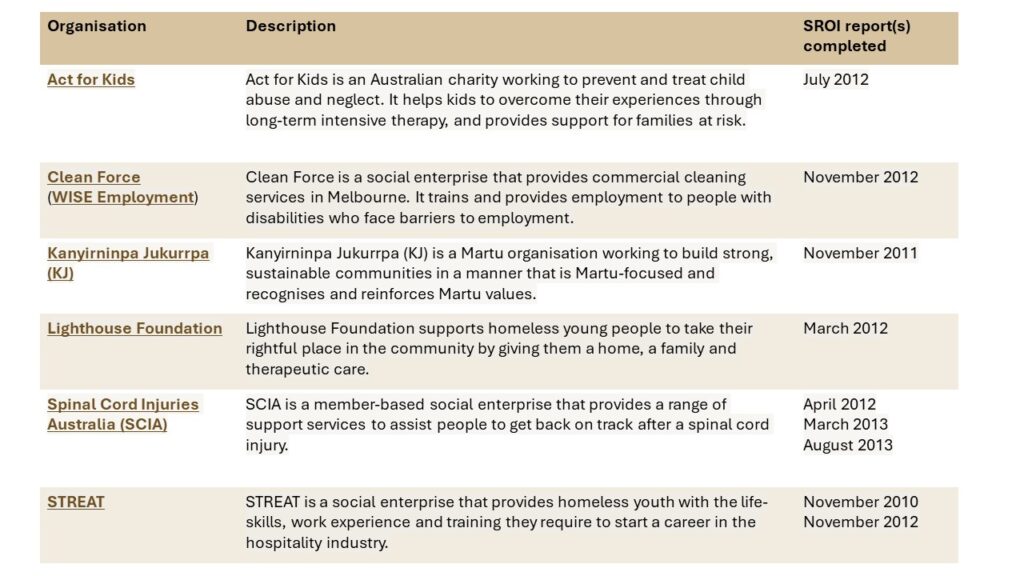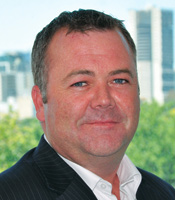
Extended benefits of an SROI report
There can be additional benefits from an SROI analysis if it is approached in the right way.

- SROI is done primarily to demonstrate impact, however, there are other benefits that many organisations do not expect.
- Unforeseen benefits include: the powerful stories that are told, a better understanding of how the programs work, insights that enable management to run the business better, and improved data collection and reporting systems.
- To help realise these benefits, organisations need to engage management and the board in the SROI process, be willing to learn and change, and nominate a champion to act on the recommendations.
SROI is about more than just demonstrating impact. And while it is primarily done for this reason – and to articulate and document the impact – many organisations gain other benefits that they don’t expect.
…testament to the organisations’ leadership and evidence of how continuous improvement works in practice. ”
SVA Consulting talked to six organisations (see Table 1) that have completed an SROI project with us over the last few years to find out what the benefits have been that they hadn’t expected and how they were realised.

Table 1
This article looks at:
- Evidence of impact – more useful than clients expected
- The additional benefits of SROI that clients didn’t foresee
- How to get these benefits from the SROI process.
Evidence of impact – more useful than clients expected
The six organisations undertook the SROI analysis to account for the value created through their operations and to evaluate their performance[1]; they wanted to ‘prove’ the outcomes and value of their program or services.
Funders have become more demanding and are no longer satisfied with knowing that an organisation ‘does good things’… ”

While they all believed strongly in their work and its value, they often struggled to ‘sell’ that story. Funders have become more demanding and are no longer satisfied with knowing that an organisation ‘does good things’; they want to see evidence of change.
As Peter Murray, General Manager of Development and Strategic Projects at Spinal Cord Injuries Australia (SCIA), says “How do we demonstrate to private donors, government agencies or any other stakeholder that we are actually making a difference in people’s lives?”
Few organisations had expectations of the process beyond getting a report that provided an independent validation of their approach and returned a ‘good ratio’.
However, having this independent valuation has, in many cases, had more influence and for longer than was expected.
“Two and a half years on, the SROI continues to be used and cited by our funders and supporters,” says Peter Johnson, CEO of Kanyirninpa Jukurrpa (KJ).

Lighthouse Foundation CEO, Kane Bowden reflects: “It [the report] has been a powerful piece of work in supporting our discussions with government. It has played a significant role in strengthening those relationships, particularly with the Victorian Government. And the Federal Government which put half a million dollars in to support our expansion was also very impressed with this independent report.”

The reports have also enhanced the organisations’ reputation in the sector by giving their work credibility. “We continue to use our reports in a variety of forums as evidence of the strength of our approach,” says Murray from SCIA. “We have also shared what we have learned nationally and internationally.”
In terms of influencing staff and supporters, Bowden describes the SROI report as “having become part of our DNA”. “We have it lying around in the office and all of our staff and many supporters are very familiar with it,” he says. “It has given us a sustained morale boost.”
… you are going to extract a great deal more benefit from the process and the report than simply the bottom line figure. ”
Additional benefits that clients didn’t foresee
For many organisations, the benefits of the SROI analysis went a lot further than they originally imagined – the analysis itself has had a lasting impact. It has helped the organisation to better understand the beneficiaries’ needs, and thus improve how it does what it does and the impact it has. It has also helped grow the supporter base.
“In our experience you are going to extract a great deal more benefit from the process and the report than simply the bottom line figure,” says Johnson (KJ).
Organisations identified four additional benefits which have had significant impact on their organisation:
- Powerful stories surfaced through interviews with beneficiaries
- Better understanding of how the programs work
- Insights that help management run the business better
- Improved data collection and reporting systems.
Powerful stories surfaced through interviews with beneficiaries
Stakeholder engagement, such as face-to-face interviews or surveys, is a fundamental part of the SROI process. It helps to identify the most important outcomes for the organisation and to develop an understanding of those outcomes from the perspective of the service beneficiaries. These are primarily clients but could also be members of their family, paying customers, members of the community where the service is delivered, or the government. It is an opportunity for these different stakeholders to express how the work of the organisation has an impact on their lives or the issues they care about.
The stories had a deep impact on me – they strengthened my belief and commitment to Clean Force’s approach.”
Stakeholder engagement has the potential to uncover stories about what matters to the individuals who are experiencing change. These stories can be inspiring and moving testimonials, and bring to life what an organisation does.
David Christian, Strategy Projects Manager of WISE Employment, sat in on interviews with Clean Force employees as they shared openly about living with debilitating mental conditions, and of how the job had fundamentally changed their lives.
He says: “The stories had a deep impact on me – they strengthened my belief and commitment to Clean Force’s approach. It really validated that employment is creating tangible benefits and that, with the right support, it helps to transform people’s lives.”
These stories, which were captured in the report through quotes, continue to be shared with all of the organisations and individuals that WISE Employment wants to influence. “The stories are important to share – to show the value that we are creating, and for the staff to see that their efforts are improving the lives of people on a daily basis,” says Christian.

It was critical to have independent people to ask the questions. I couldn’t have gone to the same depth. ”
Other organisations have used stories in a similar way: making sure the staff, service users and potential supporters know these stories boosts staff morale, gives service users hope for the future, and builds the supporter base. “The SROI collected a substantial bank of quotes from our clients that we have used in other documents, because of their relevance and incisiveness,” says Johnson (KJ).

Having an independent organisation interview stakeholders enables the ‘storyteller’ to be freer and ‘tell it like it is’; the interviewee remains anonymous. Often the interviewer can ask questions that may not be suitable for the service provider (or employer) to ask. People often don’t want to share all their personal challenges and the details of their lives to the people they work with or see every day.
“It was critical to have independent people to ask the questions. I couldn’t have gone to the same depth. I know what questions need to be asked but it would not be appropriate for me to ask these questions, or I would just hear what they [Indigenous men and women in the communities] think I want to hear,” says Katrina Lines, Executive Director of Programs, Research and Education at Act for Kids.
Better understanding of how the programs worked
All organisations found that the SROI process helped them to better understand how their programs worked and to communicate that effectively so that it was clearer to funders and other stakeholders.
At the start of the SROI analysis, the organisation develops the program logic or organisational theory of change[2] to describe the link between its activities and the impact it has. This process forces organisations to distil a complex description of how the program works into a simple and clear message. SVA Consulting incorporates program logic into all of its SROI reports.
The articulation of the program logic has been enormously valuable. ”
Through the SROI process, stakeholder engagement helps to test and refine the program logic to ensure that it provides an accurate representation of the change that is created on the ground.
This results in a much clearer message about what the organisation does and how this creates the impact it intends. This can be helpful to staff, potential funders and/or supporters.
For example, at STREAT the SROI revealed that the feeling of accomplishment for the young participants when they completed the program was of great value to them. However, it did not matter to them whether it was an industry-respected certification or another piece of paper.
“The analysis made clear that acknowledgement of smaller stepping stones along the way, rather than an emphasis on the final certification, would help build participants’ confidence and resilience,” says Rebecca Scott, STREAT CEO. “This was an ‘aha!’ moment for STREAT’s management.”

Johnson of KJ also reflects on the value that the stakeholder-informed program logic brought to his organisation. “The articulation of the program logic has been enormously valuable,” he says.
Having this program logic has helped KJ effectively communicate the benefits of this type of intervention… ”
The On-Country program run by KJ has often been interpreted by people as only having environmental outcomes. However, the form in which the program logic was represented by SVA Consulting was “an imaginative, concise and eloquent way to represent the interconnections between social, cultural, economic and environmental outcomes,” says Johnson. Having this program logic has helped KJ effectively communicate the benefits of this type of intervention to government and other funders.
Act for Kids has also found that the program logic has been an enduring framework to think about the benefits of the program for the stakeholders. “It has also helped us clarify the most important outcomes we were working towards,” says Lines.
Insights that help management run the business better
As the SROI analysis clearly links activities to consequences, management get a better understanding of the cultural and structural approaches that help create the desired impact. This helps management understand the triggers for change and identify the levers to increase the impact further. As a result, a number of organisations have improved their operations.
For example, through economic modelling of its emergency services program, SCIA found that it had spare staff capacity. “This meant that we could service more clients with our current staffing level which has made our program more efficient without compromising outcomes for our clients,” says Murray.
This has led to business growth, increased customer satisfaction and a more integrated workforce… ”
For Clean Force, the SROI highlighted the extent to which the organisation’s founders were depended on to support key processes, manage external relationships and maintain the organisational culture. And that this was a key risk for the business.
As a result, Clean Force management worked with a consultant to drive both structural and cultural changes within the business to minimise this risk and improve the business capacity.

“We had to create a sense of cultural ownership of the business across all levels of staff. This has led to business growth, increased customer satisfaction and a more integrated workforce,” says Christian.
In addition, it highlighted the importance of succession planning for our business, says WISE Employment CEO, Matthew Lambelle, “Since then we have invested heavily into planning for the next generation of leaders.”
For STREAT, the SROI helped the organisation to “focus on the critical things and has been a catalyst for a program re-design,” says Scott. Having identified the outcomes which were most important for its young people, STREAT wanted to make sure that its programs were driving more effectively towards these changes.
STREAT went from delivering one flagship program to providing a suite of shorter programs to ensure the young participants received the most appropriate support. These structural changes together with a comprehensive outcomes measurement system have provided a much stronger foundation for STREAT to grow its impact.
Improved data collection and reporting systems
In the SROI process in addition to engaging directly with stakeholders, organisations analyse other evidence of their impact, such as client questionnaires and assessments. Considering the quality of the data and the effectiveness of the data collection and evaluation processes forced some organisations to “shine the light on dark places” as Scott described it.
Once we knew the outcomes we needed to track, we could identify the best source of that data… ”
“It has been valuable to take an honest and critical look at the data we collect and to identify ways in which we can improve,” says Scott. “The SROI process has given us a big kick up the bum to get our measurement and evaluation up to scratch.”
Importantly, SROI forces organisations to focus on the critical things that need to be measured. “SROI highlighted the importance of tracking outcomes,” says Bowden (Lighthouse Foundation). “Once we knew the outcomes we needed to track, we could identify the best source of that data, such as surveys of the young people, reports from the psychologist and the carers, and the relevant quantitative testing tools.”
The Lighthouse Foundation is expanding its model of care nationally by partnering with other delivery organisations, and is sharing its outcomes tracking database with these partners. “This will provide us with data from day one,” says Bowden. “And we’ll share it with the government to ensure they continue to support Lighthouse’s approach to breaking the cycle of homelessness for young people in Australia.”
We have a faster feedback loop which means that we don’t have to wait until the next SROI analysis… ”
The SROI process provides a strong foundation for designing effective measurement and evaluation systems. This helps organisations evaluate their own performance in a more rigorous and timely way. “We have gone from patchy measurement and evaluation to being a measurement and evaluation leader!” says Scott. “We have a faster feedback loop which means that we don’t have to wait until the next SROI analysis to tell us if we are achieving the impact we want.”
How to get these benefits from the SROI process
All of the organisations have been able to make the learnings from the process ‘stick’. They have owned their results and worked hard to magnify the impact they create. This is testament to the organisations’ leadership and evidence of how continuous improvement works in practice.
Like with anything in life, you get out of the SROI what you put in… ”
“Like with anything in life, you get out of the SROI what you put in,” says Bowden. “We embraced the process and the methodology from the very beginning. There was buy-in from the top down.”
It would have been easy for organisations to just use the SROI report as a marketing tool to communicate the value of their work to potential funders. However, they have extracted benefits that they weren’t expecting.
Three factors contributed to this:
- Engaging management and the board in the process
- Being willing to learn and change
- Nominating a champion to act on recommendations.
Engaging management and the board in the process
Making sure that the management executive and the board are involved and have a good understanding of the SROI process ensures that an organisation gets both a better SROI report and that the recommendations are acted on.
We made sure that sufficient support was provided to SVA Consulting staff to reliably extract enough information from the clients… ”
When the executive are on board and understand the SROI process, they can support the analysts to develop a more complete and detailed understanding of the organisation. This may be by directing them to speak to the best stakeholders to identify where value is being created. Or by ensuring that they receive appropriate cultural or other client-specific orientation so that they can more effectively gather evidence and evaluate the impact.
“We made sure that sufficient support was provided to SVA Consulting staff to reliably extract enough information from the clients,” says Johnson (KJ). “This meant engaging senior people and key decision-makers in the organisation who understood the work delivered on the ground, but were also able to communicate the bigger vision we were pursuing. I do not think we would have achieved the outcomes we did if we had not engaged senior staff fully in the process.”
When the board is involved, it is more likely to support recommendations resulting from the SROI analysis. Scott at STREAT says that “having our board members understand and own this work ensured that we got support to make the changes that we thought were necessary”.
Being willing to learn and change
The rigour of the SROI process means that internal assumptions may be challenged – stakeholder engagement, data analysis and putting a value on outcomes can be a confronting process. For example STREAT gained insights which altered the way it saw its program.
Even though the process was at times uncomfortable, in the end it was of huge benefit to our organisation. ”
Organisations say that having an attitude of curiosity and wanting to improve were critical in making the most of the SROI process. This approach allowed them to keep open communication lines with SVA Consulting as new information was presented to them.
“Internally it can be easy to accept your own hype,” says Scott. “But we believe that objectivity is critical, so we were open to learning from the findings that SVA presented back to us. Even though the process was at times uncomfortable, in the end it was of huge benefit to our organisation.”
Nominating a champion to act on recommendations
To take advantage of the SROI analysis, it is important to nominate who will be responsible for actioning recommendations.
Consideration of the practical capacity to implement change is important… ”
Many organisations had a senior manager/CEO or a steering group engaged throughout the project with the expectation that they would continue to champion the work once the project was complete. “Consideration of the practical capacity to implement change is important and should be considered early in the project or at least before it concludes,” says Lines from Act for Kids.
It is most effective if this person or group is involved throughout the project, so that they have a thorough understanding of the process and the results.
At STREAT, once the SROI was completed, the organisation made a commitment to improve and this was made a priority at the executive and board level. This included immediately piloting, testing and finalising program changes.
To improve measurement and evaluation (M&E) in the future, STREAT established a Board Policy and Research Committee. “Members were familiar with the SROI process,” says Scott. “This group has carriage of the project to assess and implement a new M&E platform, a substantial commitment of time and financial resources.”

Thank you to all of the individuals who gave their time to share their experience of, and insights about, SROI with us. For more information, contact consulting team.

[1] SROI does this by placing a monetary value on the social impact of an activity, and compares it with the cost incurred in creating this benefit.
[2] A program logic is a framework that articulates how the activities of a program lead to the consequences (or outcomes) you seek. An organisational theory of change does the same but for the entire organisation which may include a range of different programs or activities.







